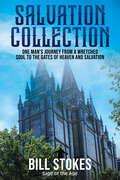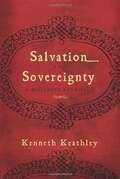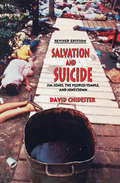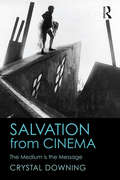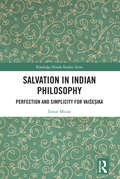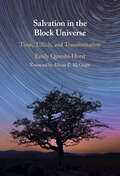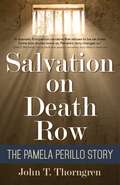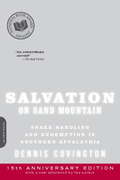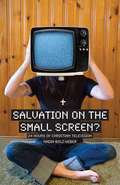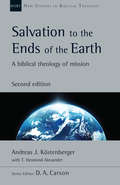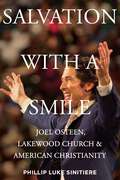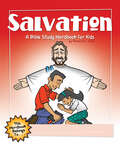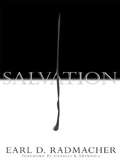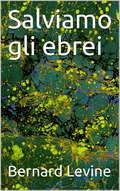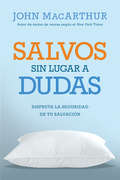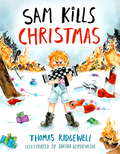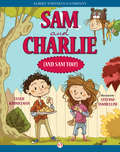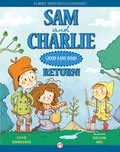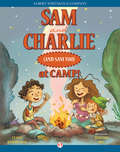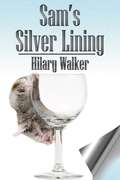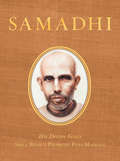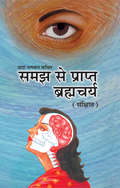- Table View
- List View
Salvation Collection: One Man's Journey from a Wretched Soul to the Gates of Heaven and Salvation
by Bill StokesI am documenting my journey, an inspired poem at a time, from baby steps to a wonderous understanding of the precepts of my salvation. I truly pray that the poetry will guide your understanding of God's grace and promise of eternal salvation. The miracle of knowing that this journey is with your family for all time brings joy beyond description. The poems are not scripture but a documentation of the truth surrounding my soul with grace and love. Using my poetry as a path by following my footsteps will help you to your salvation. My environmental work has spanned the globe and has saved and enhanced many thousands of lives, which uniquely prepared me to convey my journey in a way for you to understand and hopefully emulate.
Salvation and Sovereignty: A Molinist Approach
by Kenneth KeathleyIn Salvation and Sovereignty, Kenneth Keathley asks, “What shall a Christian do who is convinced of certain central tenets of Calvinism but not its corollaries?” He then writes, “I see salvation as a sovereign work of grace but suspect that the usual Calvinist understanding of sovereignty (that God is the cause of all things) is not sustained by the biblical witness as a whole.” <p><p>Aiming to resolve this matter, the author argues that just three of Calvinism’s five TULIP points can be defended scripturally and instead builds on the ROSES acronym first presented by Timothy George (Radical depravity, Overcoming grace, Sovereign election, Eternal life, Singular redemption). In relation, Keathley looks at salvation and sovereignty through the lens of Molinism, a doctrine named after Luis Molina (1535-1600) that is based on a strong notion of God’s control and an equally firm affirmation of human freedom.
Salvation and Suicide: Jim Jones, The Peoples Temple, and Jonestown (Religion in North America #No. 690)
by David ChidesterAn &“ambitious and courageous&” examination of the Jonestown cult viewed through the lens of theology (Journal of the American Academy of Religion). Re-issued in recognition of the 25th anniversary of the mass suicides at Jonestown, this revised edition of David Chidester&’s groundbreaking book features a new prologue that considers the meaning of the tragedy for a post-Waco, post-9/11 world. For Chidester, the murder-suicide of some 900 members of the Peoples Temple in Guyana recalls the American religious commitment to redemptive sacrifice, which for Jim Jones meant saving his followers from the evils of capitalist society. &“Jonestown is ancient history,&” writes Chidester, but it does provide us with an opportunity &“to reflect upon the strangeness of familiar . . . promises of redemption through sacrifice.&” His original conclusion that the Peoples Temple was a meaningful religious movement seems all the more prescient and astute today, when fundamentalism has raised the troubling spectre of violence and suicide all over the world.
Salvation from Cinema: The Medium is the Message
by Crystal DowningSalvation from Cinema offers something new to the burgeoning field of "religion and film": the religious significance of film technique. Discussing the history of both cinematic devices and film theory, Crystal Downing argues that attention to the material medium echoes Christian doctrine about the materiality of Christ’s body as the medium of salvation. Downing cites Jewish, Muslim, Buddhist, and Hindu perspectives on film in order to compare and clarify the significance of medium within the frameworks of multiple traditions. This book will be useful to professors and students interested in the relationship between religion and film.
Salvation in Indian Philosophy: Perfection and Simplicity for Vaiśeṣika (Routledge Hindu Studies Series)
by Ionut MoiseThis book offers a comprehensive description of the ‘doctrine of salvation’ (niḥśreyasa/ mokṣa) and Vaiśeṣika, one of the oldest philosophical systems of Indian philosophy and provides an overview of theories in other related Indian philosophical systems and classical doctrines of salvation. The book examines liberation, the fourth goal of life and arguably one of the most important topics in Indian philosophy, from a comparative philosophical perspective. Contextualising classical Greek Philosophy which contains the three goals of life (Aristotle’s Ethics), and explains salvation as first understood in the theology of the Hellenistic and Patristics periods, the author analyses six classical philosophical schools of Indian philosophy in which there is a marked emphasis on the ultimate ontological elements of the world and ‘self’. Analysing Vaiśeṣika and the manner in which this lesser known system has put forward its own theory of salvation (niḥśreyasa), the author demonstrates its significance and originality as an old and influential philosophical system. He argues that it is essential for the study of other Indian sciences and for the study of all comparative philosophy. An extensive introduction to Indian soteriology, this book will be an important reference work for academics interested in comparative religion and philosophy, Indian philosophy, Asian religion and South Asian Studies.
Salvation in New England: Selections from the Sermons of the First Preachers
by Phyllis M. Jones Nicholas R. JonesThe sermon as crafted by the early New England preachers was the most prominent literary form of its day, yet the earliest Puritan texts have as a rule been available only in rare-book collections. This anthology of sermons of the first generation of preachers fills a serious gap in American literature. The preachers collected here, the most widely published of their time, were among the eighty or more who emigrated to Massachusetts Bay during the 1630s. They are John Cotton of Boston, Thomas Shepard of Cambridge, and Thomas Hooker of Hartford, the three foremost "lights of the western churches," and two eminent colleagues, Peter Bulkeley of Concord and John Davenport, first of New Haven and later of Boston. The selections are chosen to be representative of the lengthy works from which they are drawn, to reflect the major concerns and styles of the preachers' work as a whole, and to demonstrate the genre of the sermon as developed by the early American Puritans. Not only does this anthology represent an important contribution to literary history, but the sermons also illustrate a doctrine uniquely elaborated in this period-a consistent and emphatic narrative, mythlike in its repetition and heroics, of the progress of the soul from a state of nature to a state of salvation. This theme may be seen as a three-stage-development, although individual sermons may vary. These stages-preparation, vocation, and regeneration-determine the order of the selections. The editors' introductory material supplies a comprehensive and thorough discussion of the early New England sermons, concentrating on their role, history, structure, style, and subject matter. A separate essay on the texts of the sermons describes the relationship between the early printed versions and their form as delivered in the pulpit. The introduction preceding each selection presents original research on the historical circumstances of the preaching and publication of the work from which the sermon is drawn. The editors have also provided brief biographies of the preacfiers represented here, an annotated list of recommended background reading, and the most exhaustive checklist available of authoritative editions of the sermons of these five preachers. This book will be useful to colonial specialists as well as to students of early American literature, religion, and history. The texts are critically edited for readability, with modernized spelling and annotations of unfamiliar phrases and allusions.
Salvation in the Block Universe: Time, Tillich, and Transformation
by Emily Qureshi-HurstDoes time really pass? Should theology mould itself to fit with the findings of physics and philosophy? How should the interdisciplinary dialogue between science and religion proceed? In Salvation in the Block Universe, Emily Qureshi-Hurst tackles these important questions head-on. She offers a focused treatment of a particular problem – the problem of salvation in the block universe – and a broader exploration of a theological methodology that makes 'science and religion' not only possible but desirable via Paul Tillich's method of correlation. By bringing time and salvation into dialogue, Dr Emily Qureshi-Hurst's original insights move the 'science and religion' conversation forward into new and productive territory. Qureshi-Hurst also provides tools for other theologians and philosophers to do the same. Essential reading for anyone interested in the interactions between philosophy, religion, and science, she asks: without the reality of change, is personal salvation during one's lifetime even possible?
Salvation on Death Row: The Pamela Perillo Story
by John T. Thorngren"Some true stories move us. Pamela's story changes us." - Dale S.Recinella, Chaplain for Florida's Death Row and author of Now I Walk on Death RowPamela Perillo was set to die on March 24, 1996.Convicted of capital murder in 1980, Pamela sat on Texas’s Death Row awaiting lethal injection. But less than two days before her scheduled execution, she was given a second chance, and in 2000, she was resentenced: from death to life in prison with the possibility of parole.Her first chance at new life had come shortly after her arrest, when Pamela embraced the Christian faith and began bringing her fellow inmates to redemption in Christ.That’s why although Pamela’s story is one of imprisonment—first by abuse and addiction and ultimately behind the locked doors of the criminal justice system—it’s also a story of hope—of finding a new path in faith, of taking courage from the promise of salvation, and now, of praying for parole in 2019 after nearly forty years of incarceration.Salvation on Death Row combines true-crime reporting with a powerful spiritual memoir, reminding us that every life is a journey, every person is capable of change, and every individual can make a positive impact on the world."This is a great story with a wonderful conclusion: The only good answer is the Lord!"- -Bill Glass, founder of Bill Glass MinistriesThe author's proceeds from Salvation on Death Row will benefit Patriot PAWS service dogs.
Salvation on Sand Mountain: Snake Handling and Redemption in Southern Appalachia
by Dennis CovingtonFor New York Times reporter Dennis Covington, what began as a journalistic assignment-covering the trial of an Alabama pastor convicted of attempting to murder his wife with poisonous snakes-would evolve into a headlong plunge into a bizarre, mysterious, and ultimately irresistible world of unshakable faith: the world of holiness snake handling. Set in the heart of Appalachia, Salvation on Sand Mountain is Covington’s unsurpassed and chillingly captivating exploration of the nature, power, and extremity of faith-an exploration that gradually turns inward, until Covington finds himself taking up the snakes.
Salvation on the Small Screen?: 24 Hours of Christian Television
by Nadia Bolz-WeberFrom a seminarian and stand-up comic—an “enlightening and entertaining” look at celebrity televangelists, cash, and couch-potato redemption (AJ Jacobs, author of The Year of Living Biblically). On an average day, the largest religious broadcast channel is a “divine” presence in more than 50 million households. Holding court on the political issues of the day are such figures as Joel Osteen, T.D. Jakes, Pat Robertson, Benny Hinn, and Jesse Duplantis. Yet many people have little concept of what kind of faith happens there—apart from performing miracles and selling books. A casual viewer flipping past the channel is likely to think, “I haven’t the faintest clue what’s going on,” or “That church doesn’t seem like my church at all,” or even, “Wow, so that’s what happened to Kirk Cameron.” To better understand the message of religious television, Lutheran seminarian Nadia Bolz-Weber spent 24 hours immersing herself in the phenomenon with guest viewers including a rabbi, a Unitarian minister, and her eight-year-old daughter. Augmented by a running count of all of the biblical verses used and total cost of various donations solicited and products shilled through the day, the author chronicles this hugely influential part of America’s religious landscape that is unfamiliar to many. And she never changed channels once. The result is “laugh-out-loud, hysterically funny, and also extraordinarily poignant—we need more theology done like this.” (Dr. Douglas Gay, Lecturer in Practical Theology, University of Glasgow, Scotland). “Turn off your TV and read this book. It's enlightening and entertaining and it doesn't emit any radiation whatsoever.” —AJ Jacobs, author of The Year of Living Biblically
Salvation to the Ends of the Earth: A Biblical Theology of Mission (New Studies in Biblical Theology #Volume 53)
by Andreas J. KöstenbergerFew biblical topics are as important as mission. Mission is linked inextricably to humanity's sinfulness and need for redemption and to God's provision of salvation in the person and work of Jesus Christ. This good news of salvation must be made known. The saving mission of Jesus constitutes the foundation for Christian mission, and the Christian gospel is its message. This second edition of New Studies in Biblical Theology volume Salvation to the Ends of the Earth emphasizes the way in which the Bible presents a continuing narrative of God's mission—ranging from the story of Israel to the story of Jesus and that of the early Christians. At the same time, it provides a robust historical and chronological backbone to the unfolding of the early Christian mission. The apostle Paul's writings and the General Epistles are incorporated with the Gospel with which they have the closest and most natural canonical and historical affinity. Addressing key issues in biblical theology, the works comprising New Studies in Biblical Theology are creative attempts to help Christians better understand their Bibles. The NSBT series is edited by D. A. Carson, aiming to simultaneously instruct and to edify, to interact with current scholarship and to point the way ahead.
Salvation with a Smile: Joel Osteen, Lakewood Church, and American Christianity
by Phillip Luke SinitiereJoel Osteen, the smiling preacher, has quickly emerged as one of the most recognizable Protestant leaders in the country. His megachurch, the Houston based Lakewood Church, hosts an average of over 40,000 worshipers each week. Osteen is the best-selling author of numerous books, and his sermons and inspirational talks appear regularly on mainstream cable and satellite radio. How did Joel Osteen become Joel Osteen? How did Lakewood become the largest megachurch in the U. S.?Salvation with a Smile, the first book devoted to Lakewood Church and Joel Osteen, offers a critical history of the congregation by linking its origins to post-World War II neopentecostalism, and connecting it to the exceptionally popular prosperity gospel movement and the enduring attraction of televangelism. In this richly documented book, historian Phillip Luke Sinitiere carefully excavates the life and times of Lakewood’s founder, John Osteen, to explain how his son Joel expanded his legacy and fashioned the congregation into America’s largest megachurch. As a popular preacher, Joel Osteen’s ministry has been a source of existential strength for many, but also the routine target of religious critics who vociferously contend that his teachings are theologically suspect and spiritually shallow. Sinitiere’s keen analysis shows how Osteen’s rebuttals have expressed a piety of resistance that demonstrates evangelicalism’s fractured, but persistent presence. Salvation with a Smile situates Lakewood Church in the context of American religious history and illuminates how Osteen has parlayed an understanding of American religious and political culture into vast popularity and success.
Salvation: A Bible Study Wordbook For Kids
by Richard E. ToddPerfect for use in Sunday school, Bible clubs, midweek programs, and even at home with a parent, this wordbook study on salvation introduces children to God&’s grace.Clarifying some of the difficult questions surrounding salvation, this wordbook helps children see how they have fallen short of God&’s glory and are in need of Jesus. Also provided are follow up questions to make kids understand more fully why they should believe in Jesus, and what it will mean for their lives. The wordbook guides children through the doctrine of salvation with activities like cryptograms, word searches, coloring pages, quizzes, and interviews with someone "who is part of God's family." Children also have an opportunity to become a member of God's family and complete a "Certificate of Spiritual Birth." This wordbook, designed especially for kids in grades 2–5, complements the rest of the Children&’s Wordbook series. They are great resources for parents and teachers who want to teach children the Christian doctrines of salvation, baptism, communion, giving, and theChurch.
Salvation: A Bible Study Wordbook For Kids
by Richard E. ToddPerfect for use in Sunday school, Bible clubs, midweek programs, and even at home with a parent, this wordbook study on salvation introduces children to God&’s grace.Clarifying some of the difficult questions surrounding salvation, this wordbook helps children see how they have fallen short of God&’s glory and are in need of Jesus. Also provided are follow up questions to make kids understand more fully why they should believe in Jesus, and what it will mean for their lives. The wordbook guides children through the doctrine of salvation with activities like cryptograms, word searches, coloring pages, quizzes, and interviews with someone "who is part of God's family." Children also have an opportunity to become a member of God's family and complete a "Certificate of Spiritual Birth." This wordbook, designed especially for kids in grades 2–5, complements the rest of the Children&’s Wordbook series. They are great resources for parents and teachers who want to teach children the Christian doctrines of salvation, baptism, communion, giving, and theChurch.
Salvation: Supersaver Edition (Swindoll Leadership Library)
by Earl D. RadmacherGod's ultimate gift to His children is salvation. In this volume Earl Radmacher offers an in-depth look at the most fundamental element of the Christian faith. From defining the essentials of salvation to explaining the result of Christ's sacrifice, this book walks readers through the spiritual meaning, motives, application, and eternal result of God's work of salvation in our lives.
Salvem os judeus: O que o povo judaico não sabe sobre Jesus
by Bernard Levine Diogo dos Santos FariasQue tristeza e que tragédia terrível é o fato de que a nação judaica, "O Povo das Escrituras", não crê em Jesus. Se os judeus ao menos percebessem que, sem Jesus, eles não receberão a graça maravilhosa da vida eterna. Pois, por não aceitarem Jesus como seu companheiro, os judeus também estão desperdiçando a oportunidade de experienciar o grandioso poder do que o sangue de Jesus pode fazer em suas vidas. Os judeus estão perdendo a chance de ter seus pecados remitidos e perdoados. Devido aos sacrifícios de sangue do Velho Testamento haverem cessado, e já não serem observados, os judeus não podem mais ter seus pecados expurgados e perdoados sem sangue. Há tantas coisas sobre Jesus que os judeus nunca ouviram, ou que não eles não sabem... Você vai falar de Jesus aos judeus?
Salviamo gli ebrei
by Simona Trapani Bernard LevineE' davvero triste ed è un terribile tragedia che la nazione ebraica, il 'Popolo del Libro', non creda in Gesù. Gli ebrei sono ossessionati dal rispetto di molte leggi e tradizioni create dall'uomo, stabilite dai loro rabbini. Poiché i sacrifici di sangue dell'Antico Testamento sono stati eliminati e non vengono più osservati, i peccati degli ebrei non possono essere purificati e perdonati senza sangue. Ci sono molto cose di Gesù che gli ebrei non conoscono o di cui non hanno mai sentito parlare.... E voi, parlerete agli ebrei di Gesù?
Salvos sin lugar a dudas
by John MacarthurTodos los creyentes han luchado con estas preguntas en algún momento de su vida. Salvos sin lugar a dudas trata este tema difícil, examinando las Escrituras para descubrir la verdad sobre la salvación, y a la vez analizando cuestiones difíciles que pueden obstaculizar nuestra fe. Los lectores podrán desarrollar una teología de la salvación basada en la Biblia, y ser alentados a descansar de forma segura en su relación personal con Cristo.
Sam Kills Christmas
by Thomas RidgewellSam is a small child with a big problem, they HATE Santa. And so, this Christmas, it's time to embark on a quest to vanquish that villain once and for all. Along the way, Sam will encounter Ice Queens and evil Elves, and not a few rocket launchers and explosives, but the big question is...will they be able to rid the world of the tyranny of Santa?
Sam and Charlie (and Sam Too!)
by Leslie Kimmelman Stefano TambelliniWhen Charlie moves next door to Sam, he's thrilled to have a new friend--even if she is a girl. Charlie has a little sister, also named Sam--or Sam Too, as the other Sam comes to call her. Both Sam and Charlie (and Sam Too) are Jewish, and they try to live by the religion's motto: Love your neighbor as yourself. The five brief chapters in this book, accompanied by colorful illustrations, highlight the value of friendship and its ups and downs.
Sam and Charlie (and Sam Too) Return!
by Leslie Kimmelman William OwlSam and Charlie (and Charlie's little sister, Sam Too) return with five more stories, which include a Tu B'Shevat celebration and a Hannukah competition. Accompanied by colorful illustrations, the stories highlight the value of friendship and its ups and downs. This is a fixed-format ebook, which preserves the design and layout of the original print book.
Sam and Charlie (and Sam Too) at Camp!
by Leslie Kimmelman William OwlBest friends Sam and Charlie are headed to sleepaway camp for the first time! Each day brings something new--from swimming and nature hikes to camp songs and FOAM day! At camp, Sam and Charlie learn the importance of shomrei adamah, taking care of the earth, and taking care of friendships, new and old.This is a fixed-format ebook, which preserves the design and layout of the original print book.
Sam's Silver Lining
by Hilary WalkerIn this humorous tale, Sam the devout Catholic somehow gets into bad scrapes without meaning to. Now he’s done something which threatens to destroy not only his career but also his chances with a particularly lovely coworker. His only hope is to confess to his understanding priest and place himself in God’s hands.But God works in mysterious ways. With the priest’s help, He’s looking out for the hapless Sam.
Samadhi: His Divine Grace
by Srila Bhakti Puri MaharajA special volume of writings by the founder of Sri Gopinath Gaudiya Math published to commemorate the opening of the samadhi temple built in his honor.In 2004, Swami B. P. Puri's Samadhi Mandir in Mayapur, India, was completed. The date of its inauguration, agreed upon by astrologers and devotees, was set for March 4th. This publication commemorates that auspicious day. Samadhi includes chapters on “Chanting Inattentively,” “Spiritual Entry into the Holy Dham,” and “Transcending Duality through Service to the Lord.” The book also includes an article by Swami B. B. Bodhayan, detailing Swami B. P. Puri’s auspicious advent and boyhood pastimes.
Samaj Se Prapt Brahmacharya (Sanxipt): समज से प्राप्त ब्रह्मचर्य (संक्षिप्त)
by Dada Bhagwanब्रम्हचर्य व्रत, भगवान महावीर द्वारा दिये हुए ५ महाव्रतो का हिस्सा है| मोक्ष प्राप्त करने ब्रम्हचर्य व्रत का पालन करना चाहिए, यह समझ बहुत सारे लोगो में है पर विषय करना क्यों गलत है या उसमें से हम छुटकारा कैसे पा सकते है, यह सब कोई नहीं जानता| विषय यह हमारी पाँचो इन्द्रियों में से किसी भी इन्द्रिय को पसंद नहीं आता| आँखों को देखना अच्छा नहीं लगता, नाक को सूंघना पसंद नहीं, जीभ से चख ही नहीं सकते और ना ही हाथ से छू सकते है| पर फिर भी सच्चा ज्ञान नहीं होने के कारण लोग विषय में निरंतर लीन होते है क्योंकि उन्हें इसके जोख्मों के बारे में कोई जानकारी ही नहीं है| अपने हक्क के साथी के साथ भी विषय करने में अनगिनत सूक्ष्म जीवों का नाश होता है और अनहक्क के विषय का नतीजा तो नरकगति है| इस पुस्तक द्वारा आपको ब्रम्हचर्य क्या है,इसके क्या फायदे है, ब्रम्हचर्य का पालन कैसे करे वगैरह प्रश्नों के जवाब मिलेंगे|
